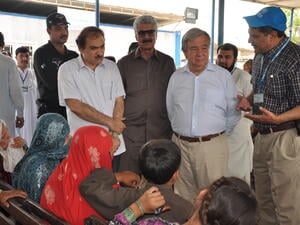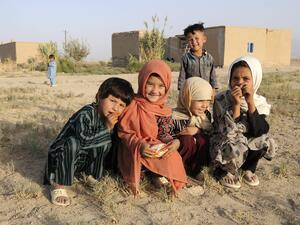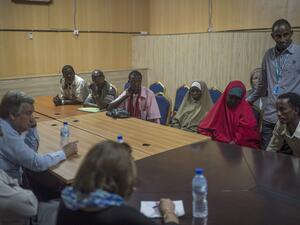Millions Uprooted
Millions Uprooted
This article was published in the September/October 2008 issue of Foreign Affairs.
The twenty-first century will be characterized by the mass movement of people being pushed and pulled within and beyond their borders by conflict, calamity, or opportunity. War and human rights violations are already scattering millions across the world in search of safety. Globalization, with its attributes of economic expansion, unresolved poverty, and enduring insecurity, is prompting many people to leave their homes in search of better lives. Climate change and environmental degradation will further exacerbate such trends. At few times in history have so many people been on the move. The extent of human mobility today is blurring the traditional distinctions between refugees, internally displaced people, and international immigrants. Yet attempts by the international community to devise policies to preempt, govern, or direct these movements in a rational manner have been erratic.
The most perilous of these mass movements are the journeys people make as refugees in search of safety. In 1951, the UN Refugee Convention set out the criteria for assigning refugee status to people (refugee status is accorded to people forced to leave their countries because of persecution or armed conflict), and the Office of UN High Commissioner for Refugees (UNHCR) was established with a mandate to protect and find solutions for refugees. But in the almost six decades since, new patterns of movement, including forms of forced displacement not envisaged by the Refugee Convention, have emerged. A bipolar world in which people fled from communist states, as many Hungarians did in 1956, or escaped repressive military regimes, as did many Chileans fleeing Augusto Pinochet's regime between 1973 and 1976, has given way to a world in which population flows are propelled by a complex combination of interrelated factors. When, for example, a country such as Zimbabwe began to implode, how were the millions of Zimbabweans crossing the border into South Africa in search of a semblance of a decent life be qualified? Initially, most moved because of severe economic or social hardship caused by their country's descent into economic and social chaos, but seldom did they qualify for refugee status or even request asylum. Only later, as conditions deteriorated, did persecution and violence become the main driver of their flight.
People moving between countries and continents, voluntarily or involuntarily, especially in the absence of legal permits, face detention, harassment, and discrimination, as well as the risk of transfer to remote and dangerous locations. In contravention of the 1951 Refugee Convention, refugees continue to be turned away from the borders of countries where they hope to find safety. Asylum and immigration issues are not always addressed in an equitable manner. Political populism and sensationalist media coverage have promoted a sense of fear of refugees and moves to reject them, even in traditionally hospitable countries. In such a world, the UNHCR confronts a disconnect between the limited formal mandate of protecting refugees and the immense scope of forced displacement around the world today. With the Iraq crisis, the number of refugees worldwide has started to climb again after years of decline; it now stands at almost 11.5 million. More than twice that number of people -- perhaps 26 million, including around 3 million Iraqis -- are displaced within their countries. And there are 200 million immigrants in the world.
The international community needs to establish a cooperative legal and policy framework based on humanitarian principles that will ensure that people who have fled serious economic, social, or environmental crises in their own countries are not subsequently deported from the countries to which they have fled. Rather, temporary forms of protection and material assistance, at the least, should be provided to the most vulnerable among them. People who need international protection must have access to the territory of other states and be allowed to make their cases in fair and effective asylum procedures. Border controls should be designed to be sensitive to the rights and safety of refugees. The lives of people in distress on the high seas must be saved by ensuring their safe and timely disembarkation. Crackdowns on human smugglers and traffickers need to be intensified and their victims protected. And governments must seek new ways to provide for safe and legal immigration to their countries. The UNHCR can be a central player in a new humanitarian-protection compact built with other international organizations and based on universal values, human rights, and international law.
COMMON PROTECTIONS
Technology has connected the world in ways that would have been unimaginable even two decades ago. Isolationism is almost impossible to pursue. The open flow of ideas and information has freed and empowered many people. And a broad consensus has emerged on the principle that all human beings have inalienable rights that sovereign states have an obligation to uphold. I subscribe to the notion of a "responsibility to protect" (R2P), which was endorsed by leaders at the UN's 2005 World Summit. The R2P doctrine maintains that a state's sovereignty is inseparable from its responsibility to protect the people living in its territory and cannot be merely a form of control, and that the international community has a duty to take appropriate action when this responsibility is neglected or violated. This is not an open invitation to military intervention, which must always be an option of last resort, exercised only in exceptional circumstances. Rather, it is an urgent call to states to assume their rightful role in recognizing, respecting, and protecting the rights of their people.
The post-Cold War view that the sovereignty of the individual can sometimes override state sovereignty in situations of genocide, crimes against humanity, and ethnic cleansing has become unpopular recently. The crisis in Iraq has revived more traditional interpretations of state sovereignty. Most of the developing world sees the R2P as a conceptual camouflage designed to enable the Western states to pursue their interests by interfering in less prosperous countries. But a reinvigorated global consensus on the R2P has to be forged nonetheless. Last century's genocides in Africa, Asia, and Europe are reminders that the rejection of unilateral intervention should not allow authoritarian governments to believe that state sovereignty and the principle of noninterference will protect them as they terrorize and slaughter their citizens. The sovereignty of the individual must be paramount.
The UNHCR's everyday work reveals the difficulties of providing even minimal protection to millions of at-risk human beings. A step forward is often followed by a step backward as a fragile peace unravels, a refugee camp is arbitrarily dismantled, or a hostile government deems the UNHCR's presence to be undesirable. The space for humanitarian action is being squeezed within an ever more restricted perimeter, and humanitarian workers are increasingly targeted by terrorist attacks -- as, for instance, in the deadly assaults on UN offices in Baghdad in 2003 and Algiers in December 2007, which left dozens dead or maimed.
Nevertheless, the effort to extend the reach of international humanitarian law and broaden the international community's commitment to safeguarding human rights is an inexorable process. It is part of what the journalist Lawrence Weschler has called "a decades-long, at times maddeningly halting, vexed, and compromised effort to expand the territory of law itself." The territory of law is often synonymous with the territory in which human life, even the most fragile, is protected.
LAWLESS ROADS
In December 2007, I visited the Nord-Kivu region of the Democratic Republic of the Congo. Over the last year, conflict, increasing militarization, and spiraling lawlessness had displaced some 400,000 people there -- the worst displacement in the region since the end of the Congolese civil war in 2003. Four hundred thousand people had already been uprooted by the war, and the displaced people in this one part of the country now number around 800,000. In several squalid camps housing tens of thousands of displaced people, I listened to account after account of Congolese who had lost control over their lives.
People talked about their suffering at the hands of the armed men who roam the countryside murdering, maiming, raping, and robbing with impunity. A woman described how the armed men gouged out one of her eyes and raped her. Even when the victims have managed to reach refugee camps, safety is elusive. Armed men arrive there and harass them. "Where must we go to be safe?" an elderly man asked me in a shelter near the town of Goma. "Where is the end for us?" And there is not enough food or water or shelter in the camps. There are no schools, jobs, or maternity clinics either.
The plight of these people illustrates a major problem for the humanitarian community and in particular for the UNHCR: how to protect the rights of internally displaced persons such as the millions uprooted in Iraq, Darfur, Sri Lanka, and Colombia. During a mission to Iraq in February, I met with several internally displaced Iraqis in a dusty camp near the northern town of Erbil. Most of the 150 families living there had fled their homes in the Mosul area in 2005. Despite Mosul's relative proximity, they received neither their pension payments nor their food rations, and few had much hope of returning home anytime soon. It is a tragedy that the continuing insecurity in Iraq prevents international aid agencies from doing more to help them or the 2.8 million other internally displaced Iraqis throughout the country.
Meanwhile, the terrible plight of more than two million internally displaced people in Sudan's Darfur region and around 250,000 refugees in neighboring Chad presents one of the most difficult challenges anywhere for the UNHCR and the rest of the international community. In my visits to the region, desperate displaced people have repeatedly reminded me that their lives are in almost constant danger. "Our main concern is security," said one elder at Krinding, a camp of some 34,000 internally displaced people on the outskirts of the Darfur town of Geneina. "We cannot move. People get shot. Many women have been raped. We can't sleep because we're afraid we will be killed." I could only answer that if there is no peace, there is no solution, and that the international community must do more to bring about peace. I fear that the nights in Krinding and in other crowded camps in Darfur remain sleepless and terrifying.
These people have been forced out of their homes by conflict and violence but have not crossed an international border. In theory, states that are parties to the core UN human rights treaties recognize their obligations to all their citizens, including those who have been displaced. In practice, however, countries with large populations of displaced people often lack the means, and sometimes the will, to provide their displaced populations with adequate protection and assistance.
International help is usually needed, and it is critical that the UNHCR and other international organizations be granted safe and unhindered access to countries in which people have been internally displaced. As it is in postconflict situations, it is essential to coordinate these efforts to eliminate overlaps and gaps in the provision of services. Some progress has been made since the UN emergency relief coordinator initiated a reform that has enabled international organizations -- including UN agencies, the International Red Cross and Red Crescent Movement, and various nongovernmental organizations -- to establish a consensual division of labor (known as "the cluster approach") in humanitarian emergencies.
Thanks to this approach, the UNHCR is now working with around 14 million internally displaced persons in 23 countries. Still the UNHCR's ability to function in such circumstances remains conditional on the ability of the staff to gain access to the populations concerned with an acceptable level of safety. Clear parameters are needed to define what the R2P actually involves and to ensure that unacceptable barriers to humanitarian action are not erected by either state or nonstate actors in the countries involved.
LONG WAY HOME
The world's displaced people demonstrate impressive resourcefulness and enterprise despite the horrifying difficulties they face in the struggle to rebuild their lives. In Afghanistan, for example, Hamida, an 18-year-old mother who recently returned from Iran under a UNHCR repatriation program, has settled in the country's remote central highlands in Bamiyan. Her family had fled Afghanistan in 1989 when she was two and eked out a living in the Iranian city of Isfahan for 16 years. After the fall of the Taliban, the family felt that it should return home, not least because Iran no longer appeared willing to accommodate them.
Hamida has begun a new life with an uncertain future, raising her infant child in a bare home while earning $1 a day for weaving traditional Afghan carpets. Many of the 50,000 Afghans who have returned to the Bamiyan area from Iran over the past five years live in caves in the cliff where the two famous Bamiyan Buddhas stood before they were destroyed by the Taliban. Violence has marked the landscape of Afghanistan and is etched on the faces of its returning refugees. Despite the difficulties, international assistance has helped the country make some progress in recent years. More than four million Afghan refugees have returned, mainly from Pakistan, in one of the largest population movements since World War II. They have been able to put their children, including their daughters, in new schools. And a growing number of Afghans are, for the first time, within a day's walk of a clinic.
International assistance tends to come too slowly to those refugees and displaced people who have returned to war-torn societies. Last year, I accompanied five trucks of refugees returning from exile in Uganda to southern Sudan. Many of the refugees had fled two decades ago during the civil war between the North and the South of Sudan. Despite a 2005 peace settlement between the government and the opposition forces, they were anxious about what they would find at home. After a two-hour ride over dirt tracks, I walked the final few hundred yards with Helene (a woman in her mid-30s) and her husband, both returning refugees, and their four children. A refugee camp is no place to raise a family, but at least in Uganda, Helene's family had food, shelter, schools, and medical care. They were returning to a home that lacked just about everything. As we skirted fields of maize and peanuts overlooking a lush green valley, her husband explained that they had fled the area in 1987 and, after 20 years in exile, were now ready to confront the challenge of rebuilding their lives in their own country. Helene knew life would not be easy. But with peace and continued international support, people like her could rebuild.
The international community must do everything possible to demonstrate to the tens of thousands of families like Helene's that their courageous choice to return home is the right one. When situations begin to improve -- as they have in places such as Afghanistan, Burundi, Liberia, Sierra Leone, and southern Sudan -- the transition from immediate relief to longer-term development and peace building must be encouraged and expedited. Poorly designed reconstruction programs in postconflict areas must be improved and competing institutional competencies eliminated. The lack of local governance capacity in many of these countries is aggravated by their limited human resources and compounded by the international community's failure to act in a coordinated and effective way. The quick wins necessary to meet refugees' expectations and renew their hope remain elusive, leaving open the possibility that armed conflict and political violence will flare up once again. Newly returned internally displaced people and refugees are among the most vulnerable people in such situations.
Failed and failing states represent the darker side of globalization. Transnational crime and terrorism flourish in regions where states are unable to provide their citizens with physical, material, or legal security. The UNHCR's most intractable challenges lie in these regions. Policy frameworks must be found to ensure that the international community deploys all the tools at its disposal -- aid, trade, diplomacy, security, and relief -- to usher countries from failure toward sustainable stability. In many fragile and uneasy parts of the world, war and peace exchange places like shuffling cards. The UNHCR often works in these areas, trying to mediate intractable situations in which human lives are tossed to the winds. Beyond the return and reintegration of displaced people, what is at stake is providing hope and preserving peace, cohesion, and democracy in societies ravaged by cycles of conflict and displacement. Without stability, newly returned refugees may have no alternative but to scurry to some new destination, their dreams of a more settled life falling apart once again.
ONE FRAGILE WORLD
"Interconnectedness" is a long word for a simple notion: what any one person does anywhere increasingly affects everyone else everywhere. The decision of a motorist in Chicago or a factory owner in Shanghai can end up changing the way of life of a peasant in Chad. Such chain reactions can have both positive and negative effects. With their potential to force millions more to move from their lands, the punitive effects of such chain reactions on a planetary scale are preventable only if the international community works together.
In the coming decades, human displacement is likely to be worsened by climate change. Scientists generally agree that unless radical action is taken to curb global warming, the livelihoods and security of people in many parts of the world will be at risk, especially in the poorest countries of Africa and the delta regions of Asia. Food supplies are already dwindling, and prices are soaring on the global market. Some island states, such as Tuvalu and the Maldives, are concerned that their very existence will eventually be threatened by rising sea levels. Natural disasters that kill and displace millions of people, usually the poorest and the most vulnerable, have become more frequent.
In military jargon, climate change could be called a "force multiplier." It both displaces people and intensifies other factors that make people move. In Darfur, a Janjaweed attack on a village may appear to be motivated by politics, but at a deeper level it may be about a water shortage that has set herders against farmers. Al Gore, former U.S. vice president and an eminent environmental activist, estimates that environmental changes that cause the sea level to rise by one centimeter would displace a million people. Although there is a growing awareness of the perils of climate change, its likely impact on human displacement and mobility has received too little attention.
A global compact to tackle mass displacement must respect the principles of international solidarity and responsibility sharing. In the industrialized states, governments sometimes forget that the issue of human mobility is not simply one of movement from the South to the North. Indeed, the majority of the world's refugees are to be found in developing countries, and some of the largest migratory movements take place within the South. Efforts to improve the situation of refugees in developing regions are certainly needed, but they must not be used as a pretext by the world's most prosperous countries to dump humanitarian-protection problems on states with fewer resources and less capacity to deal with mass influxes. Refugee protection in the South can never be an alternative to asylum in the North. A fast-growing and increasingly mobile human population needs a new humanitarian-protection compact. Global stability will hinge on the ability of states to share in harmony and with greater equity the fruits of a shrinking planet.







